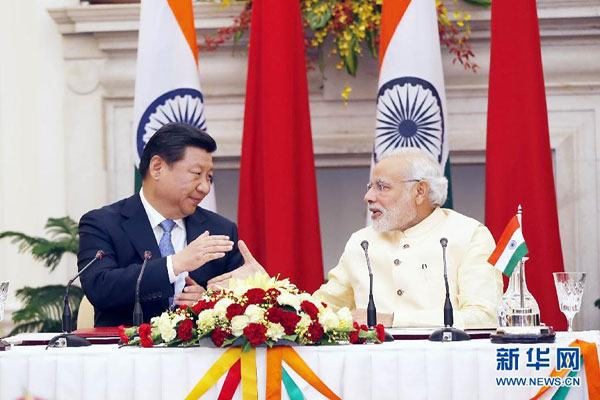India and China will keep contributing to global architecture
Updated: 2016-01-09 09:25
By Ashok K. Kantha(China Daily)
|
|||||||||
 |
|
President Xi Jinping and Indian Prime Minister Narendra Modi shake hands at a press conference in New Delhi, India, Sept 18, 2014. [Photo/Xinhua] |
During the intensive interaction, I was struck by the high level of warmth and interest the students and faculty displayed toward India. For me, it was a potent symbol of the infinite distance India and China have traveled together and a strong indicator of the potential of closer engagement.
As we have entered a new year - and I complete my tenure in China - it is a time to reflect on the successes of the past year. During his visit to India in September 2014, President Xi Jinping emphasized: "China and India have a combined population of over 2.5 billion. If we speak with one voice, the whole world will listen, and if we join hands, the whole world will pay attention." On that occasion, our leaders articulated the vision of closer developmental partnership between India and China.
Prime Minister Narendra Modi's visit to China in May 2015 took up the momentum. The two visits showcased the high level of personal rapport between our leaders and coined a new term, "hometown diplomacy". Modi has met with Xi and Premier Li Keqiang as many as eight times over the last 18 months.
India welcomes China's participation in our development campaigns such as "Made in India", "Digital India", and "Smart Cities". And we are happy to note that investments from China are flowing into India.
Indian companies, too, can play a greater role in China's strategic initiatives such as "Made in China 2025" and "Digital China", which emphasize innovation, and research and development. India's strengths in information technology and knowledge industries converge well with these aspirations. Also, India is a global lead player in pharmaceuticals and can slot into China's health strategy. With asymmetrical trade being a mutual concern, such initiatives can make economic engagement more sustainable.
Related Stories
China and India Development Round Table Conference held 2015-12-04 13:54
China, India need open domestic market wider to each other: expert 2015-11-24 17:06
Senior Chinese officer starts mission to Pakistan and India 2015-11-13 07:53
India most attractive investment destination by global investors 2015-10-20 11:03
Today's Top News
Inspectors to cover all of military
Britons embrace 'Super Thursday' elections
Campaign spreads Chinese cooking in the UK
Trump to aim all guns at Hillary Clinton
Labour set to take London after bitter campaign
Labour candidate favourite for London mayor
Fossil footprints bring dinosaurs to life
Buffett optimistic on China's economic transition
Hot Topics
Lunar probe , China growth forecasts, Emission rules get tougher, China seen through 'colored lens', International board,
Editor's Picks

|

|

|

|

|

|







